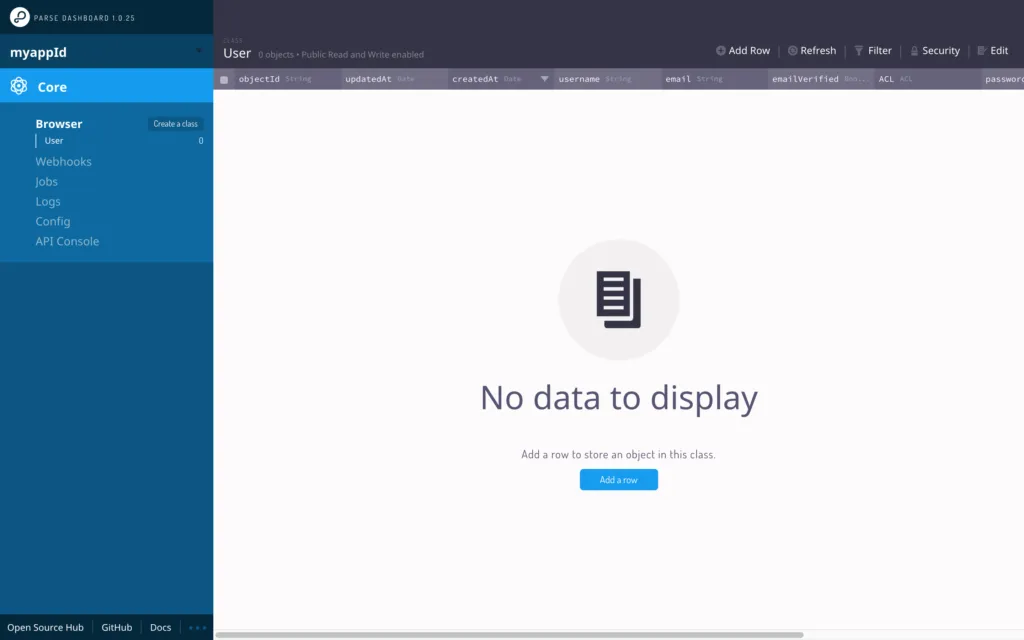Parse is a well-known open source Mobile Backend-as-a-Service
If you haven't seen the previous post on how to run Parse Server on OpenShift, please take a look Parse Server on OpenShift Online (Next Gen).
Here, I'll focus more on dashboard and Parse Server integration. Running Parse mobile backend on OpenShift has been greatly simplified and made available in a few commands.
Note: If you're using self-signed certs for your router, then you need to accept them for the dashboard URL and Parse Server URL, otherwise you may see issues.
Create a Namespace and Provide Appropriate Permissions
$ oc new-project parse
$ oc adm policy add-scc-to-user anyuid -z default -n parse
$ oc adm policy add-scc-to-user privileged -z default -n parse
Importing Parse Server Example Template
$ oc create -f https://raw.githubusercontent.com/parse-community/parse-server-example/master/openshift.json
$ oc new-app parse-server-example -e APP_ID=myappid -e MASTER_KEY=supersecret
$ oc patch route/parse-server-example -p '{"spec":{"tls": {"termination":"edge"}}}'
$ oc get routes -l app=parse-server-example -o jsonpath='{.items[*].spec.host}'
$ PARSE_SERVER_URL=$(oc get routes -l app=parse-server-example -o jsonpath='{.items[*].spec.host}')
$ PARSE_SERVER_URL='https://'$PARSE_SERVER_URL'/parse'
$ oc volume dc/mongodb --remove --name mongodb-data #incase you dont have persistent volume
Deploy Parse Dashboard
$ oc project parse
$ oc new-app https://github.com/parse-community/parse-dashboard.git \
-e PARSE_DASHBOARD_ALLOW_INSECURE_HTTP=true \
-e PARSE_DASHBOARD_SERVER_URL=$PARSE_SERVER_URL \
-e PARSE_DASHBOARD_MASTER_KEY="supersecret" \
-e PARSE_DASHBOARD_APP_ID="myappid" \
-e PARSE_DASHBOARD_APP_NAME="MyApp" \
-e PARSE_DASHBOARD_USER_ID="user1" \
-e PARSE_DASHBOARD_USER_PASSWORD="pass"
$ oc expose dc parse-dashboard --port=4040
$ oc expose svc parse-dashboard
$ oc patch route/parse-dashboard -p '{"spec":{"tls": {"termination":"edge"}}}'
$ oc get routes
How to Use?
Open the the dashboard URL and use the following credentials for logging into the Parse Dashboard: user1/pass

Conclusion
You can deploy and scale your Parse Server easily using OpenShift. OpenShift has the capability to autoscale, so deploy your Parse Server and set it to scale on demand.
For simplicity, this post did not use a persistent volume, but if you need data persisted use OpenShift volumes.
執筆者紹介
類似検索
チャンネル別に見る
自動化
テクノロジー、チームおよび環境に関する IT 自動化の最新情報
AI (人工知能)
お客様が AI ワークロードをどこでも自由に実行することを可能にするプラットフォームについてのアップデート
オープン・ハイブリッドクラウド
ハイブリッドクラウドで柔軟に未来を築く方法をご確認ください。
セキュリティ
環境やテクノロジー全体に及ぶリスクを軽減する方法に関する最新情報
エッジコンピューティング
エッジでの運用を単純化するプラットフォームのアップデート
インフラストラクチャ
世界有数のエンタープライズ向け Linux プラットフォームの最新情報
アプリケーション
アプリケーションの最も困難な課題に対する Red Hat ソリューションの詳細
オリジナル番組
エンタープライズ向けテクノロジーのメーカーやリーダーによるストーリー
製品
ツール
試用、購入、販売
コミュニケーション
Red Hat について
エンタープライズ・オープンソース・ソリューションのプロバイダーとして世界をリードする Red Hat は、Linux、クラウド、コンテナ、Kubernetes などのテクノロジーを提供しています。Red Hat は強化されたソリューションを提供し、コアデータセンターからネットワークエッジまで、企業が複数のプラットフォームおよび環境間で容易に運用できるようにしています。
言語を選択してください
Red Hat legal and privacy links
- Red Hat について
- 採用情報
- イベント
- 各国のオフィス
- Red Hat へのお問い合わせ
- Red Hat ブログ
- ダイバーシティ、エクイティ、およびインクルージョン
- Cool Stuff Store
- Red Hat Summit

